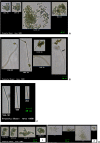Using FlowCam and molecular techniques to assess the diversity of Cyanobacteria species in water used for food production
- PMID: 36348060
- PMCID: PMC9643327
- DOI: 10.1038/s41598-022-23818-1
Using FlowCam and molecular techniques to assess the diversity of Cyanobacteria species in water used for food production
Abstract
Globally, the occurrence of cyanobacteria in water currently remains an important subject as they produce cyanotoxins that pose threat to human health. Studies on the contamination of maize meals during mill grinding processes using cyanobacteria-contaminated water have not been conducted. The present study aimed to assess the diversity of cyanobacteria in the samples (process water, uncooked maize meal, and cooked maize meal (porridge)). Polymerized Chain Reaction (PCR) and Advanced digital flow cytometry (FlowCAM) were used to detect and identify cyanobacterial species available in these samples. 16S Primers (forward and reverse) tailed with Universal Sequences were used for amplification and sequencing of full-length 16S rRNA genes from cyanobacteria found in all samples. Cyanobacterial species from order Nostocales, Pseudanabaenales, Oscillatoriales Chroococcales, Synechococcales, and unclassified cyanobacterial order, some of which have the potential to produce cyanotoxins were amplified and identified in process water, raw maize meal and porridge samples using PCR. Images of the genus Microcystis, Phormidium, and Leptolyngbya were captured in process water samples using FlowCAM. These findings show the presence of cyanobacteria species in process water used for maize meal and the absence in cooked maize meal. The presence of cyanobacteria in process water is likely another route of human exposure to cyanotoxins.
© 2022. The Author(s).
Conflict of interest statement
The authors declare no competing interests.
Figures





References
-
- Jagals P, Fosso-Kenkeu E, du Preez H. Exposure of rural households to toxic cyanobacteria in container-stored water. Water S. A. 2008;34:131–136.
-
- Almuhtaram H, Kibuye FA, Ajjampur S, Glover CM, Hofmann R, Gaget V, Owen C, Wert EC, Zamyadi A. State of knowledge on early warning tools for cyanobacteria detection. Ecol. Ind. 2021;133:108442.
-
- Mutoti M, Gumbo J, Jideani AIO. Occurrence of cyanobacteria in water used for food production: A review. Phys. Chem. Earth Parts A B C. 2022;125:103101.
Publication types
MeSH terms
Substances
Grants and funding
LinkOut - more resources
Full Text Sources

